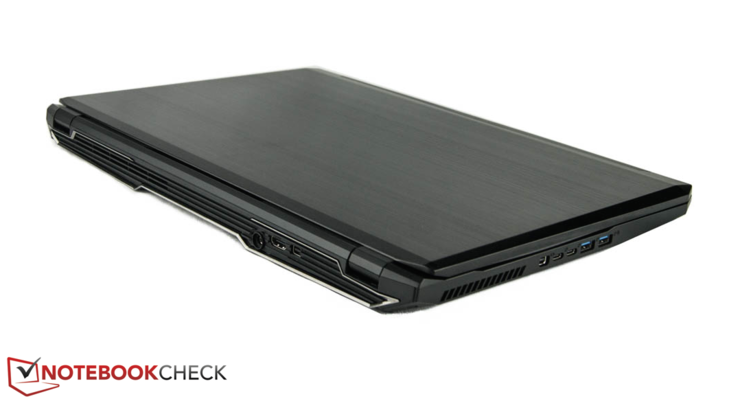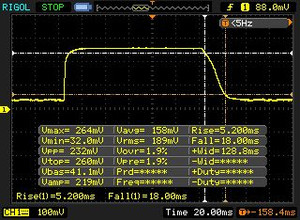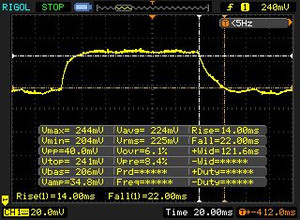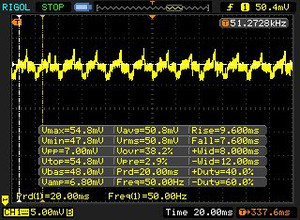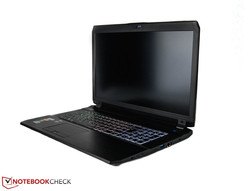Breve análisis del Nexoc G734III (Clevo P670RS-G)
Top 10 Análisis
» Top 10 Portátiles Multimedia
» Top 10 Portátiles de Juego
» Top 10 Portátiles de Juego ligeros
» Top 10 Portátiles Asequibles de Oficina/Empresa
» Top 10 Portátiles de Juego Ligeros
» Top 10 Portátiles de Oficina/Empresa Premium
» Top 10 Estaciones de Trabajo
» Top 10 Subportátiles
» Top 10 Ultrabooks
» Top 10 Convertibles
» Top 10 Tablets
» Top 10 Tablets Windows
» Top 10 Tablets de menos de 250 Euros
» Top 10 Phablets (>5.5")
» Top 10 Smartphones
» Top 10 Smartphones (≤5")
» Top 10 Smartphones de menos de 300 Euros
» Top 10 Smartphones de menos de 120 Euros
» Top 10 Portátiles de menos de 1000 Euros
» Top 10 Portátiles de menos de 500 Euros
» Top 10 Portátiles de menos de 300 Euros
» Los Mejores Displays de Portátiles Analizados por Notebookcheck
| SD Card Reader | |
| average JPG Copy Test (av. of 3 runs) | |
| MSI GT73VR-6RE16SR451 | |
| MSI GT72VR 6RE-015US | |
| Acer Predator 17 G9-793-77LG | |
| Nexoc G734III | |
| Asus G752VS-XB78K | |
| maximum AS SSD Seq Read Test (1GB) | |
| MSI GT73VR-6RE16SR451 | |
| MSI GT72VR 6RE-015US | |
| Acer Predator 17 G9-793-77LG | |
| Asus G752VS-XB78K | |
| Nexoc G734III | |
| Networking | |
| iperf Server (receive) TCP 1 m | |
| MSI GT73VR-6RE16SR451 | |
| Nexoc G734III | |
| Asus G752VS-XB78K | |
| Acer Predator 17 G9-793-77LG | |
| iperf Client (transmit) TCP 1 m | |
| Acer Predator 17 G9-793-77LG | |
| MSI GT73VR-6RE16SR451 | |
| Asus G752VS-XB78K | |
| Nexoc G734III | |
| |||||||||||||||||||||||||
iluminación: 92 %
Brillo con batería: 314 cd/m²
Contraste: 1121:1 (Negro: 0.28 cd/m²)
ΔE ColorChecker Calman: 4.17 | ∀{0.5-29.43 Ø4.78}
ΔE Greyscale Calman: 3.84 | ∀{0.09-98 Ø5}
86% sRGB (Argyll 1.6.3 3D)
56% AdobeRGB 1998 (Argyll 1.6.3 3D)
62.8% AdobeRGB 1998 (Argyll 3D)
85.8% sRGB (Argyll 3D)
67.4% Display P3 (Argyll 3D)
Gamma: 2.41
CCT: 6950 K
| Nexoc G734III LG Philips LP173WF4-SPD1 (LGD046C), 1920x1080 | MSI GT73VR-6RE16SR451 N173HHE-G32 (CMN1747), 1920x1080 | MSI GT72VR 6RE-015US LG Philips LGD046E, 1920x1080 | Asus G752VS-XB78K LG Philips LP173WF4-SPF3 (LGD04E8), 1920x1080 | Acer Predator 17 G9-793-77LG AU Optronics B173ZAN01.0 (AUO109B), 3840x2160 | |
|---|---|---|---|---|---|
| Display | 29% | 1% | -1% | 35% | |
| Display P3 Coverage (%) | 67.4 | 91.2 35% | 68.3 1% | 66.9 -1% | 86.9 29% |
| sRGB Coverage (%) | 85.8 | 100 17% | 86.7 1% | 85.2 -1% | 100 17% |
| AdobeRGB 1998 Coverage (%) | 62.8 | 84.9 35% | 63.4 1% | 62.3 -1% | 99.4 58% |
| Response Times | 49% | -3% | -1% | -4% | |
| Response Time Grey 50% / Grey 80% * (ms) | 36 ? | 26 ? 28% | 34.4 ? 4% | 38 ? -6% | 37 ? -3% |
| Response Time Black / White * (ms) | 23 ? | 6.8 ? 70% | 25.2 ? -10% | 22 ? 4% | 24 ? -4% |
| PWM Frequency (Hz) | 50 ? | ||||
| Screen | -28% | 4% | 3% | 13% | |
| Brightness middle (cd/m²) | 314 | 314 0% | 348.7 11% | 328 4% | 336 7% |
| Brightness (cd/m²) | 308 | 294 -5% | 327 6% | 317 3% | 320 4% |
| Brightness Distribution (%) | 92 | 89 -3% | 89 -3% | 88 -4% | 88 -4% |
| Black Level * (cd/m²) | 0.28 | 0.23 18% | 0.323 -15% | 0.3 -7% | 0.25 11% |
| Contrast (:1) | 1121 | 1365 22% | 1080 -4% | 1093 -2% | 1344 20% |
| Colorchecker dE 2000 * | 4.17 | 9.74 -134% | 4.09 2% | 3.74 10% | 3.61 13% |
| Colorchecker dE 2000 max. * | 8.94 | 15.71 -76% | 9.02 -1% | 8.97 -0% | 6.02 33% |
| Greyscale dE 2000 * | 3.84 | 9.58 -149% | 2.14 44% | 2.67 30% | 4.78 -24% |
| Gamma | 2.41 91% | 2.5 88% | 2.25 98% | 2.41 91% | 2.32 95% |
| CCT | 6950 94% | 11854 55% | 6885 94% | 6861 95% | 6185 105% |
| Color Space (Percent of AdobeRGB 1998) (%) | 56 | 76 36% | 56.9 2% | 56 0% | 88 57% |
| Color Space (Percent of sRGB) (%) | 86 | 100 16% | 86.5 1% | 85 -1% | 100 16% |
| Media total (Programa/Opciones) | 17% /
-6% | 1% /
3% | 0% /
2% | 15% /
15% |
* ... más pequeño es mejor
Tiempos de respuesta del display
| ↔ Tiempo de respuesta de Negro a Blanco | ||
|---|---|---|
| 23 ms ... subida ↗ y bajada ↘ combinada | ↗ 5 ms subida | |
| ↘ 18 ms bajada | ||
| La pantalla mostró buenos tiempos de respuesta en nuestros tests pero podría ser demasiado lenta para los jugones competitivos. En comparación, todos los dispositivos de prueba van de ##min### (mínimo) a 240 (máximo) ms. » 50 % de todos los dispositivos son mejores. Eso quiere decir que el tiempo de respuesta es peor que la media (20.2 ms) de todos los dispositivos testados. | ||
| ↔ Tiempo de respuesta 50% Gris a 80% Gris | ||
| 36 ms ... subida ↗ y bajada ↘ combinada | ↗ 14 ms subida | |
| ↘ 22 ms bajada | ||
| La pantalla mostró tiempos de respuesta lentos en nuestros tests y podría ser demasiado lenta para los jugones. En comparación, todos los dispositivos de prueba van de ##min### (mínimo) a 636 (máximo) ms. » 49 % de todos los dispositivos son mejores. Eso quiere decir que el tiempo de respuesta es peor que la media (31.6 ms) de todos los dispositivos testados. | ||
Parpadeo de Pantalla / PWM (Pulse-Width Modulation)
| Parpadeo de Pantalla / PWM detectado | 50 Hz | ≤ 5 % de brillo | |
La retroiluminación del display parpadea a 50 Hz (seguramente usa PWM - Pulse-Width Modulation) a un brillo del 5 % e inferior. Sobre este nivel de brillo no debería darse parpadeo / PWM. La frecuencia de 50 Hz es bajísima, por lo que el parpadeo puede causar fatiga visual y cefaleas cuando se usa mucho tiempo. Comparación: 53 % de todos los dispositivos testados no usaron PWM para atenuar el display. Si se usó, medimos una media de 8118 (mínimo: 5 - máxmo: 343500) Hz. | |||
| Cinebench R11.5 | |
| CPU Single 64Bit | |
| MSI GT73VR-6RE16SR451 | |
| Asus G752VS-XB78K | |
| Nexoc G734III | |
| MSI GT72VR 6RE-015US | |
| CPU Multi 64Bit | |
| MSI GT73VR-6RE16SR451 | |
| Asus G752VS-XB78K | |
| MSI GT72VR 6RE-015US | |
| Nexoc G734III | |
| PCMark 8 | |
| Home Score Accelerated v2 | |
| Asus G752VS-XB78K | |
| MSI GT73VR-6RE16SR451 | |
| MSI GT72VR 6RE-015US | |
| Nexoc G734III | |
| Acer Predator 17 G9-793-77LG | |
| Work Score Accelerated v2 | |
| Asus G752VS-XB78K | |
| MSI GT73VR-6RE16SR451 | |
| MSI GT72VR 6RE-015US | |
| Nexoc G734III | |
| PCMark 7 Score | 5233 puntos | |
| PCMark 8 Home Score Accelerated v2 | 4180 puntos | |
| PCMark 8 Creative Score Accelerated v2 | 5262 puntos | |
| PCMark 8 Work Score Accelerated v2 | 5011 puntos | |
ayuda | ||
| Nexoc G734III Samsung SM951 MZVPV256HDGL m.2 PCI-e | MSI GT73VR-6RE16SR451 2x Samsung SM951 MZVPV256HDGL (RAID 0) | MSI GT72VR 6RE-015US SanDisk SD8SNAT256G1122 | Asus G752VS-XB78K Toshiba NVMe THNSN5512GPU7 | |
|---|---|---|---|---|
| CrystalDiskMark 3.0 | 53% | -61% | 16% | |
| Read Seq (MB/s) | 1917 | 3285 71% | 529 -72% | 1718 -10% |
| Write Seq (MB/s) | 1283 | 2560 100% | 338.5 -74% | 1305 2% |
| Read 512 (MB/s) | 871 | 1775 104% | 288.9 -67% | 1250 44% |
| Write 512 (MB/s) | 1199 | 2327 94% | 319.2 -73% | 1438 20% |
| Read 4k (MB/s) | 51 | 52.2 2% | 23.1 -55% | 44.42 -13% |
| Write 4k (MB/s) | 142.1 | 153.1 8% | 99.4 -30% | 154.4 9% |
| Read 4k QD32 (MB/s) | 603 | 627 4% | 147.5 -76% | 744 23% |
| Write 4k QD32 (MB/s) | 382.4 | 527 38% | 236.9 -38% | 578 51% |
| 3DMark | |
| 1920x1080 Fire Strike Graphics | |
| MSI GT73VR-6RE16SR451 | |
| MSI GT72VR 6RE-015US | |
| Asus G752VS-XB78K | |
| Nexoc G734III | |
| Acer Predator 17 G9-793-77LG | |
| 2560x1440 Time Spy Graphics | |
| MSI GT73VR-6RE16SR451 | |
| Asus G752VS-XB78K | |
| Nexoc G734III | |
| 3DMark 11 - 1280x720 Performance GPU | |
| MSI GT73VR-6RE16SR451 | |
| Asus G752VS-XB78K | |
| Acer Predator 17 G9-793-77LG | |
| Nexoc G734III | |
| MSI GT72VR 6RE-015US | |
| 3DMark 11 Performance | 15486 puntos | |
| 3DMark Ice Storm Standard Score | 85380 puntos | |
| 3DMark Cloud Gate Standard Score | 22639 puntos | |
| 3DMark Fire Strike Score | 12458 puntos | |
| 3DMark Time Spy Score | 4990 puntos | |
ayuda | ||
| The Witcher 3 - 1920x1080 Ultra Graphics & Postprocessing (HBAO+) | |
| Acer Predator 17 G9-793-77LG | |
| Asus G752VS-XB78K | |
| Nexoc G734III | |
| Doom - 1920x1080 Ultra Preset AA:SM | |
| Nexoc G734III | |
| MSI GT72VR 6RE-015US | |
| BioShock Infinite - 1920x1080 Ultra Preset, DX11 (DDOF) | |
| Asus G752VS-XB78K | |
| MSI GT72VR 6RE-015US | |
| Nexoc G734III | |
| bajo | medio | alto | ultra | |
|---|---|---|---|---|
| BioShock Infinite (2013) | 194 | 178.8 | 152.6 | 122 |
| The Witcher 3 (2015) | 203 | 157 | 98.1 | 53.2 |
| Doom (2016) | 149 | 142 | 127 | 119.7 |
Ruido
| Ocioso |
| 31 / 32 / 33 dB(A) |
| Carga |
| 49 / 50 dB(A) |
 | ||
30 dB silencioso 40 dB(A) audible 50 dB(A) ruidosamente alto |
||
min: | ||
| Nexoc G734III GeForce GTX 1070 Mobile, 6700HQ | MSI GT73VR-6RE16SR451 GeForce GTX 1070 Mobile, 6820HK | MSI GT72VR 6RE-015US GeForce GTX 1070 Mobile, 6700HQ | Asus G752VS-XB78K GeForce GTX 1070 Mobile, 6820HK | Acer Predator 17 G9-793-77LG GeForce GTX 1070 Mobile, 6700HQ | |
|---|---|---|---|---|---|
| Noise | 3% | 3% | 4% | -4% | |
| apagado / medio ambiente * (dB) | 30 | 30 -0% | 28.9 4% | 30 -0% | 31 -3% |
| Idle Minimum * (dB) | 31 | 32 -3% | 32.4 -5% | 31 -0% | 33 -6% |
| Idle Average * (dB) | 32 | 33 -3% | 32.4 -1% | 32 -0% | 34 -6% |
| Idle Maximum * (dB) | 33 | 35 -6% | 32.4 2% | 33 -0% | 40 -21% |
| Load Average * (dB) | 49 | 35 29% | 39.4 20% | 40 18% | 44 10% |
| Load Maximum * (dB) | 50 | 49 2% | 52 -4% | 47 6% | 50 -0% |
* ... más pequeño es mejor
(-) La temperatura máxima en la parte superior es de 50 °C / 122 F, frente a la media de 40.4 °C / 105 F, que oscila entre 21.2 y 68.8 °C para la clase Gaming.
(-) El fondo se calienta hasta un máximo de 60.5 °C / 141 F, frente a la media de 43.3 °C / 110 F
(+) En reposo, la temperatura media de la parte superior es de 27.1 °C / 81# F, frente a la media del dispositivo de 33.9 °C / 93 F.
(+) Los reposamanos y el panel táctil alcanzan como máximo la temperatura de la piel (33.6 °C / 92.5 F) y, por tanto, no están calientes.
(-) La temperatura media de la zona del reposamanos de dispositivos similares fue de 28.9 °C / 84 F (-4.7 °C / -8.5 F).
| Nexoc G734III GeForce GTX 1070 Mobile, 6700HQ | MSI GT73VR-6RE16SR451 GeForce GTX 1070 Mobile, 6820HK | MSI GT72VR 6RE-015US GeForce GTX 1070 Mobile, 6700HQ | Asus G752VS-XB78K GeForce GTX 1070 Mobile, 6820HK | Acer Predator 17 G9-793-77LG GeForce GTX 1070 Mobile, 6700HQ | |
|---|---|---|---|---|---|
| Heat | -4% | 5% | 7% | 5% | |
| Maximum Upper Side * (°C) | 50 | 44.9 10% | 40.6 19% | 42.9 14% | 42.6 15% |
| Maximum Bottom * (°C) | 60.5 | 51.2 15% | 59.4 2% | 41.5 31% | 44.9 26% |
| Idle Upper Side * (°C) | 29.1 | 32.7 -12% | 28.2 3% | 31.6 -9% | 33.1 -14% |
| Idle Bottom * (°C) | 26.9 | 34.2 -27% | 27.8 -3% | 29.5 -10% | 28.9 -7% |
* ... más pequeño es mejor
Nexoc G734III análisis de audio
(±) | la sonoridad del altavoz es media pero buena (74 dB)
Graves 100 - 315 Hz
(±) | lubina reducida - en promedio 14.7% inferior a la mediana
(-) | los graves no son lineales (15.4% delta a la frecuencia anterior)
Medios 400 - 2000 Hz
(+) | medios equilibrados - a sólo 2.9% de la mediana
(±) | la linealidad de los medios es media (7.4% delta respecto a la frecuencia anterior)
Altos 2 - 16 kHz
(+) | máximos equilibrados - a sólo 1.9% de la mediana
(+) | los máximos son lineales (4.8% delta a la frecuencia anterior)
Total 100 - 16.000 Hz
(±) | la linealidad del sonido global es media (16.2% de diferencia con la mediana)
En comparación con la misma clase
» 39% de todos los dispositivos probados de esta clase eran mejores, 7% similares, 54% peores
» El mejor tuvo un delta de 6%, la media fue 18%, el peor fue ###max##%
En comparación con todos los dispositivos probados
» 25% de todos los dispositivos probados eran mejores, 5% similares, 69% peores
» El mejor tuvo un delta de 4%, la media fue 24%, el peor fue ###max##%
MSI GT73VR-6RE16SR451 análisis de audio
(+) | los altavoces pueden reproducir a un volumen relativamente alto (#82 dB)
Graves 100 - 315 Hz
(±) | lubina reducida - en promedio 6.2% inferior a la mediana
(+) | el bajo es lineal (6.4% delta a la frecuencia anterior)
Medios 400 - 2000 Hz
(+) | medios equilibrados - a sólo 1.6% de la mediana
(+) | los medios son lineales (5.3% delta a la frecuencia anterior)
Altos 2 - 16 kHz
(±) | máximos más altos - de media 6.6% más altos que la mediana
(+) | los máximos son lineales (6.8% delta a la frecuencia anterior)
Total 100 - 16.000 Hz
(+) | el sonido global es lineal (13.8% de diferencia con la mediana)
En comparación con la misma clase
» 21% de todos los dispositivos probados de esta clase eran mejores, 7% similares, 72% peores
» El mejor tuvo un delta de 6%, la media fue 18%, el peor fue ###max##%
En comparación con todos los dispositivos probados
» 15% de todos los dispositivos probados eran mejores, 4% similares, 82% peores
» El mejor tuvo un delta de 4%, la media fue 24%, el peor fue ###max##%
Asus G752VS-XB78K análisis de audio
(±) | la sonoridad del altavoz es media pero buena (76 dB)
Graves 100 - 315 Hz
(±) | lubina reducida - en promedio 9.6% inferior a la mediana
(±) | la linealidad de los graves es media (10.7% delta a frecuencia anterior)
Medios 400 - 2000 Hz
(+) | medios equilibrados - a sólo 4.7% de la mediana
(±) | la linealidad de los medios es media (10.3% delta respecto a la frecuencia anterior)
Altos 2 - 16 kHz
(±) | máximos reducidos - de media 8.3% inferior a la mediana
(±) | la linealidad de los máximos es media (9.7% delta a frecuencia anterior)
Total 100 - 16.000 Hz
(±) | la linealidad del sonido global es media (22.4% de diferencia con la mediana)
En comparación con la misma clase
» 80% de todos los dispositivos probados de esta clase eran mejores, 6% similares, 15% peores
» El mejor tuvo un delta de 6%, la media fue 18%, el peor fue ###max##%
En comparación con todos los dispositivos probados
» 65% de todos los dispositivos probados eran mejores, 6% similares, 30% peores
» El mejor tuvo un delta de 4%, la media fue 24%, el peor fue ###max##%
| Off / Standby | |
| Ocioso | |
| Carga |
|
Clave:
min: | |
| Nexoc G734III GeForce GTX 1070 Mobile, 6700HQ | MSI GT73VR-6RE16SR451 GeForce GTX 1070 Mobile, 6820HK | MSI GT72VR 6RE-015US GeForce GTX 1070 Mobile, 6700HQ | Asus G752VS-XB78K GeForce GTX 1070 Mobile, 6820HK | Acer Predator 17 G9-793-77LG GeForce GTX 1070 Mobile, 6700HQ | |
|---|---|---|---|---|---|
| Power Consumption | -57% | -37% | -35% | -51% | |
| Idle Minimum * (Watt) | 13 | 31 -138% | 22.3 -72% | 24 -85% | 25 -92% |
| Idle Average * (Watt) | 20 | 35 -75% | 27.3 -37% | 31 -55% | 35 -75% |
| Idle Maximum * (Watt) | 27 | 40 -48% | 30 -11% | 36 -33% | 46 -70% |
| Load Average * (Watt) | 90 | 106 -18% | 152.2 -69% | 94 -4% | 103 -14% |
| Load Maximum * (Watt) | 210 | 218 -4% | 204.2 3% | 204 3% | 223 -6% |
* ... más pequeño es mejor
| Nexoc G734III 60 Wh | MSI GT73VR-6RE16SR451 75.2 Wh | MSI GT72VR 6RE-015US 83 Wh | Asus G752VS-XB78K 90 Wh | Acer Predator 17 G9-793-77LG 88 Wh | |
|---|---|---|---|---|---|
| Duración de Batería | -13% | -3% | -7% | -9% | |
| Reader / Idle (h) | 6.7 | 4.8 -28% | 5.4 -19% | 5.2 -22% | 4.6 -31% |
| H.264 (h) | 3.5 | 3.1 -11% | |||
| WiFi v1.3 (h) | 3 | 3.4 13% | 3.7 23% | 3.5 17% | 3.3 10% |
| Load (h) | 1.6 | 1.2 -25% | 1.4 -12% | 1.4 -12% | 1.5 -6% |
Pro
Contra
Aparte de defectos menores, el Nexoc G734III (Clevo P670RS-G) convence de verdad. La carcasa de gama alta puntúa con su buena calidad y su peso relativamente bajo. En general, el 17" no puede brillar con portabilidad, pero es más fácil de llevar a cuestas que otros portátiles de gama alta. Por desgracia no tiene escotillas de mantenimiento que faciliten el acceso a los componentes internos. Por otro lado, nos gustó el teclado y el touchpad retroiluminados.
Otro pro es el display IPS mate y de rico contraste con soporte G-Sync. La GeForce GTX 1070 normalmente puede con 1920 x 1080 pixels con facilidad. El modelo Pascal alcanza su límite en los 4K a partir de los 3840 x 2160 pixels. Gracias a la modernísima gráfica, la mayoría de juegos van fluidos con los detalles al máximo.
Sin embargo, la alta frecuencia del ruido de ventilador nos resultó molesta, lo que se puede minimizar usando un headset o subiendo el volumen de los altavoces. El aumento de temperatura también es mejroable. Por último, el aguante de batería es bastante modesto a pesar del intercambio de gráfica.
Por lo demás, el Nexoc G734III cumple con todos los requisitos de un portátil de juego.
Los que tengan un presupuesto aún más amplio y quieran una mejor gestión del calor deben tener en cuenta los MSI GT73VR o GT72VR, el Acer Predator 17 o el Asus G752VS.
Ésta es una versión acortada del análisis original. Puedes leer el análisis completo en inglés aquí.
Nexoc G734III
- 09/11/2016 v5.1 (old)
Nino Ricchizzi




